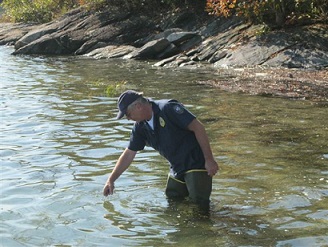 Thanks to all of our volunteers for your help and support!
Thanks to all of our volunteers for your help and support!
DMR protects public health by monitoring coastal water quality and toxic phytoplankton in all shellfish harvesting areas. Water quality data are needed to regulate shellfish growing areas to ensure that only pollution-free areas are open to harvesting. Water samples are collected monthly from January through December. Phytoplankton volunteers collect water samples in the spring, summer, and fall using light microscopes to identify toxic phytoplankton species. Volunteers work independently after receiving training and equipment needed to collect samples.
Volunteer Application and Waiver
Growing Area Program: Water Quality
- Volunteer quality assurance training
- Water sampling field data sheet - pdf file, 2 Page
- Water sampling field data sheet for GPS coordinates - pdf file, 11 KB
- Volunteer standard operating procedure - pdf file, 398 KB
Growing Area Program: Biotoxin
- Phytoplankton Monitoring Program Decision Tree (PDF file, 1 page).
- Phytoplankton Field Collection Guide (Word doc, 1 page)
- Phytoplankton Cell Counting Guide (Word doc, 1 page)
- Counting Data Sheet (PDF file, 1 page)
- Phytoplankton Identification Guide 1 - Identification Key (PDF file, 2 pages, 4 MB)
- Phytoplankton Identification Guide 2 - Common Phytoplankton of Blue Hill Bay (PDF file, 4 pages, 2 MB)
- Phytoplankton Identification Guide 3 - Common Gulf of Maine Phytoplankton (PDF file, 4 pages, 4MB)
- Phytoplankton Identification Guide 4 - Common Phytoplankton Key (JPG file, 1 page, 1 MB)
- Phytoplankton Identification Guide 5 - HAB Species not Found in the Gulf of Maine (PDF file, 2 pages, 281KB)
- Phytoplankton Identification Guide 6 - Phytoplankton Images at 10X (PDF file, 73 pages, 20MB)
- Alexandrium Can Be Difficult to Identify (Word docx, 3 pages)
- Pseudo-nitzschia Species Sizes (PDF file, 1 page)